|
NEWS NOTES — NEWS
Paleontology
Largest fossilized forest found in mine
 Bill DiMichele, National Museum of Natural History |
| Some trunks of fossilized Lycopsid trees, pieces of which have been found in other coal beds, were embedded whole in the roof of an Illinois coal mine. |
Deep within a maze of coal mines nestled along the eastern edge of Illinois, an ancient swamp forest lies perfectly still. Preserved at its time of death by a catastrophic flood 307 million years ago, the fossilized vegetation is a snapshot of a long-extinct woodland ecosystem.
The fossilized Pennsylvanian-age forest is preserved at the contact between a layer of shale and the Herrin coal bed below. Miners digging in the tunnels saw huge trunks dangling from the roof where researchers later found fossilized ground plants and even a few shellfish.
The 1,000-hectare (2,470-acre) spread may be the most expansive ancient woodland known to have been preserved in an instant of geologic time, the researchers wrote in the May 2007 Geology. “Flood, bang, bury” is how lead author Bill DiMichele of the Smithsonian’s National Museum of Natural History describes the forest’s final days. The site is so well-preserved that fossilized leaves were still on their branches. “And we’ve found another within the Illinois Basin that’s even larger,” DiMichele says.
The type of sediments and how they were buried gave clues that the mire forest was entombed by a flood. Because the layers of coal and overlying shale are clearly defined and the remains are so perfectly preserved, the researchers say the forest could have been submerged within two months. Given the tectonic nature of the region during the Pennsylvanian epoch, the flood could have been triggered by earthquakes along a nearby fault, say DiMichele and his collaborators. They suggest that this flooding was similar to the one that submerged the lowland Missouri forest and formed Reelfoot Lake during the magnitude-8 New Madrid earthquakes in the early 19th century.
The findings are providing new context and perspective on Pennsylvanian-age vegetation, DiMichele says. The lack of plant species recovered from many other ancient swamp sites has been assumed to be due to limited sample size or lack of preservation. The new find revealed nearly 30 plant species, and because this fossilized forest is so vast and so exceedingly well-preserved at “time-zero,” the researchers suggest that limited diversity may have been the natural characteristic of some ancient ecosystems.
The researchers also discovered trunks of tree species that scientists had previously known mainly from seeds and leaves. “It is amazing,” DiMichele says. “There were tree trunks everywhere, and what tipped us off [to the value of the site] was there were trunks from tree ferns that we don’t always see — that’s extremely unusual — and trunks from seed ferns, also an uncommon thing to find.”
The study has implications even in modern times. By gaining a clearer picture of what ancient mires looked like, researchers can better understand how swamps around the world can change in real time as global temperatures increase. “We’re looking at whether systems really behave like models,” DiMichele says. “Modern ecology doesn’t really have the time reach, but these studies give that extra perspective.”

 Subscribe
Subscribe


